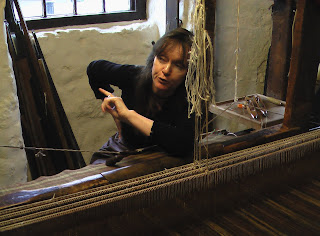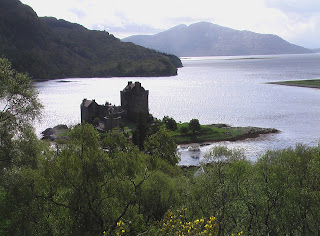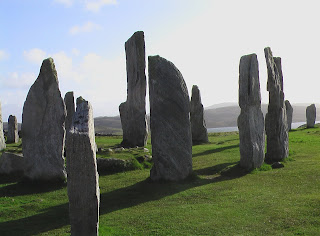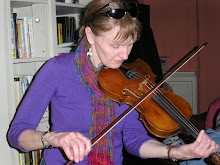 Monday 4 May. Here is the group I’ve traveled with the past two weeks. These are a bunch of ambitious spinners, weavers, knitters and sewers. The group came from Florida, New Mexico and California. They had varied interests from scuba diving, to birding to playing the cello. Each group I bring to Scotland has a different personality and I must say that this group asked great questions! If you’ve felt Scotland calling you, I welcome you to come with next year. I’ll have the dates and open registration on my website for the 2010 tour by the end of May.
Monday 4 May. Here is the group I’ve traveled with the past two weeks. These are a bunch of ambitious spinners, weavers, knitters and sewers. The group came from Florida, New Mexico and California. They had varied interests from scuba diving, to birding to playing the cello. Each group I bring to Scotland has a different personality and I must say that this group asked great questions! If you’ve felt Scotland calling you, I welcome you to come with next year. I’ll have the dates and open registration on my website for the 2010 tour by the end of May.
On the last day of our tour we headed south from Fort William through the stunning scenery of Glencoe glen. A number of movies, including the 3rd Harry Potter, have used this area as a set. The tragic massacre of the MacDonalds of 1692 continues to give this area of natural beauty a tragic air. Andrew played a recording of "Glencoe Massacre" which made us all quietly contemplate. Much of the land in the glen is now owned and protected by the National Trust of Scotland. We stopped at the view point of "The Three Sisters" mountains.
 Our last bit of nature before heading back to Glasgow was a stop on the shores of Loch Lomand where we sang “The Bonnie Banks o Loch Lomond” It was penned by a prisoner of the Jacobite campaigns before he was executed. He believed that his spirit, upon execution, would travel back the spirit world via the “low road” to the place of his birth, Loch Lomond, while his prison mate, who was to be set free, would have to walk back home to Loch Lomond. So this gives new light to these words: “You’ll take the high road and I’ll take the low road and I’ll be in Scotland afore ye. But me and my true love will never meet again on the Bonny bonny Banks of Loch Lomond.”
Our last bit of nature before heading back to Glasgow was a stop on the shores of Loch Lomand where we sang “The Bonnie Banks o Loch Lomond” It was penned by a prisoner of the Jacobite campaigns before he was executed. He believed that his spirit, upon execution, would travel back the spirit world via the “low road” to the place of his birth, Loch Lomond, while his prison mate, who was to be set free, would have to walk back home to Loch Lomond. So this gives new light to these words: “You’ll take the high road and I’ll take the low road and I’ll be in Scotland afore ye. But me and my true love will never meet again on the Bonny bonny Banks of Loch Lomond.” 
Upon returning full circle to Glasgow we lunched at Pollok House in Pollok Park. The kitchens of this fine old mansion have been turned into a café. After lunch we had a short stop at the Burrell Collection, also in the park. Sir William Burrell amassed great wealth in the shipping business and spent his money on collecting artwork from all over the world. There are many tapestries in the collection. Entry to the museum is free and walking around the park which has a large herd of Highland cattle, flowers, and trees, is a green peaceful retreat in the middle of the city, although a bit wet on this rainy day. http://www.glasgowmuseums.com/venue/index.cfm?venueid=1
We ended the tour much the way we started, with historical weaving at the Kilbarchan Weavers Cottage.Christine McLeod is the weaver and property manager at the site. The
 date on the house is 1723, but people were probably living here as early at 1650. At the peak of handloom weaving here, the 1830’s, there were 800 looms in this parish, a standard 4 shaft, 4 treadle loom. The men were generally the weavers and the women and children wound the pirns that carried the weft yarn in the shuttle. But they do know that from 1880-1890, a mother and her 4 daughters lived in the cottage and they all wove. This house has a treasured collection from
date on the house is 1723, but people were probably living here as early at 1650. At the peak of handloom weaving here, the 1830’s, there were 800 looms in this parish, a standard 4 shaft, 4 treadle loom. The men were generally the weavers and the women and children wound the pirns that carried the weft yarn in the shuttle. But they do know that from 1880-1890, a mother and her 4 daughters lived in the cottage and they all wove. This house has a treasured collection from 
 weaver Willie Meikle. He left 18 boxes of weaving samples from everything he made as a production weaver. He died in 1955. The loom Christine weaves on was Willie’s. Willie was famous for making a double weave tartan, very rare. One was just recently donated to the house so were able to touch it. The guild of weavers had 3 cats with shuttles in their mouth on their banner. When the weavers completed their apprentice ship, they swore to eat their shuttles before giving up the secrets of their trade.
weaver Willie Meikle. He left 18 boxes of weaving samples from everything he made as a production weaver. He died in 1955. The loom Christine weaves on was Willie’s. Willie was famous for making a double weave tartan, very rare. One was just recently donated to the house so were able to touch it. The guild of weavers had 3 cats with shuttles in their mouth on their banner. When the weavers completed their apprentice ship, they swore to eat their shuttles before giving up the secrets of their trade.Christine is currently thrilled to have been granted a commission to design and weave the cover for the bed in which Robert Burns was born. “I’m obsessed by Burns at the moment.
 I'm doing what Burns was familiar with. For me its about the history. It’s the story and the weavers that went before.”www.nts.org.uk/Property/62/
I'm doing what Burns was familiar with. For me its about the history. It’s the story and the weavers that went before.”www.nts.org.uk/Property/62/I want to thank our coach driver/guides Richard and Andrew from Rabbies Trail Burners http://www.rabbies.com/ onc for driving us 1692 miles around the country. If you can’t come to Scotland, then see it through Richard’s photographs of scenic Scotland on his website. http://www.scotlandthroughthelens.com/
I also want to thank Paul C. for letting me use some of his photographs to supplement my own for this blog.
Travel is a wonderful teacher. We leave our framework of our normal, everyday lives, and are thrust into a culture, which may not seem so different from our own. But as we talk, eat, ride on ferries, visit museums, breath in deeply, we learn in subtle and sometimes not so subtle ways, that every culture has unique things they offer to the world. Scotland has always offered her friendly people and welcoming nature to me and I believe my travelers felt this too. We fly back home and leap back into our lives, but we are not the same. Our being has been touched and changed. I always come home so thankful for the affordable food, fuel and energy we are privileged to have in North America . And I’m reminded to give back the hospitality to visitors in our communities and homes that we received in Scotland. Thank you for blogging along on the journey.







































